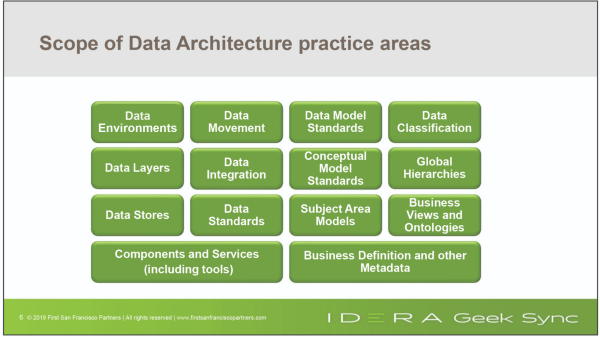Earlier this month, our founder and CEO Kelle O’Neal was the featured speaker on a Data Architecture and Data Governance: A Powerful Data Management Duo webinar.
The program was sponsored by IDERA, a company that helps businesses design, develop and deploy enterprise data with productivity tools that can minimize risk and maximize profitability.
On the webinar, Kelle talked about the critical aspects of aligning data architecture and data governance, with a focus on:
- Why aligning data architecture and data governance is important
- Key intersections of people, processes and technology between data architecture and data governance
- How data architecture and data governance work together to enforce standards
- Capabilities that data governance can apply to data architecture without interfering
- How your project and development methodologies can help drive alignment
What follows are key remarks from the webinar. If you’d like to hear Kelle’s entire presentation, you can find it in IDERA’s resource library.

Data architecture is a collection of different practice areas. Some align directly to technology, and others support the best, most-efficient use of technology — e.g., data standards.
Definitions and Distinctions
Kelle began the presentation with some level-setting, saying that data architecture is a collection of practice areas — and how these can be generally organized into components, services and tools and business definitions and metadata.
Kelle defined data governance as the organizing framework for establishing the strategy, objectives and policy for effectively managing enterprise data — the processes, policies, organization and technologies required to manage and ensure the availability, usability, integrity, consistency, auditability and security of data.
She also noted similarities in the way data architecture and data governance operate in that they both have a framework, an enterprise perspective that data supports the organization, and both seek to establish processes that are sustainable and forward-looking.

When they work together, the data architecture and data governance areas can find synergies and success in overcoming common obstacles.
Common Obstacles to Alignment
For those in an organization who work on data architecture or data governance initiatives, they often find they share a common set of obstacles — and that it makes sense to work together to overcome the challenges.
Shared obstacles for the data architecture and data governance areas include:
- Competing priorities and lack of resources
- Data ownership and other territorial issues
- Lack of cross-business unit coordination
- Lack of understanding of the architecture and governance practice areas
- Resistance to change or transformation
- Lack of executive sponsorship and buy-in
- Resistance to accountability
- Lack of business justification
- Organizational inexperience with cross-functional initiatives
- Personnel changes, where people move on or are unavailable for other reasons
How Architecture and Governance Work Together
When data governance creates the framework for establishing and enforcing the policies, procedures and standards to make data consistent, available, trusted and consumable across the enterprise, data architecture can apply these same rules of the road to their work. This benefits architecture’s efforts to effectively drive data creation, storage and application development and further the organization’s data capabilities.
The governance area can also offer guidance to the data architecture practice area by helping them align to governance practices – and to help their work get prioritized from a business perspective. And as the data architecture area works, in turn, with IT, it can identify opportunities for the governance area that helps governance be linked to the IT side of the organization.
Why Alignment Matters
Working together, the architecture and governance teams will benefit from an aligned relationship in the organization by:
- Ensuring things are being done “right” (the right projects and priorities using the right data)
- Reducing time-to-market for projects and new investments
- Reducing costs (e.g., reduced headcount in multiple roles trained to perform governance tasks)

Kelle O’Neal’s Data Architecture and Data Governance webinar was part of IDERA’s Geek Sync series, where IT and data professionals can grow their expertise and connect with industry influencers.
Catch the Replay
Register for the IDERA webinar replay here to learn from the additional material Kelle covered in the one-hour webinar, including: shared governance considerations; alignment technologies and operating models; and an overview of our project engagement methodology, Data-Centric Development Life Cycle.

